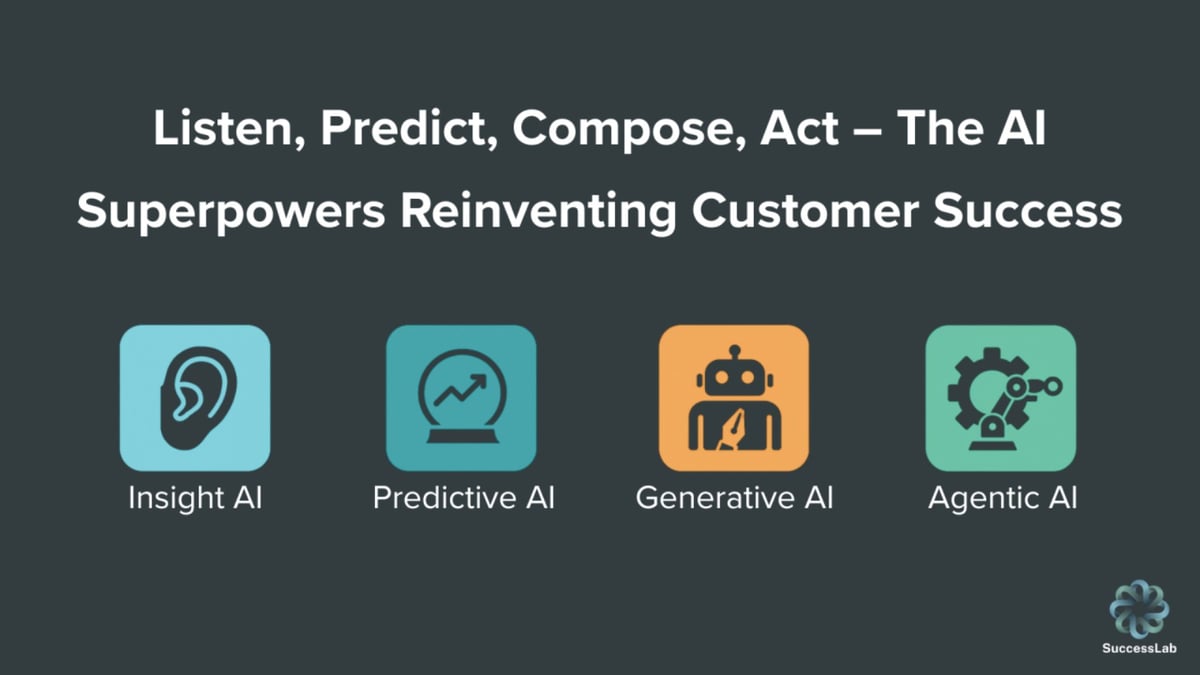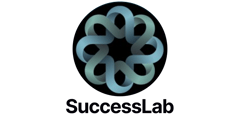Listen, Predict, Compose, Act – The AI Superpowers Reinventing Customer Success

Omid Razavi
April 18, 2025
Artificial intelligence is already transforming the daily work of Customer Success and Support teams, but using AI is not as simple as pressing an “on” button. In practice, it manifests in four separate powers that build upon one another. First, you listen to what customers and systems are saying. Then you predict what they’re likely to do next. Next, you compose clear messages and documents in seconds. Finally, you act on routine tasks automatically.
This article explores each of those superpowers in turn. For each one, you’ll learn what the technology does, the basic data and tools you need before you start, and the business benefits you can expect once it’s running. You’ll also see common pitfalls—messy data, mistrusted models, overly loose guardrails—and simple ways to avoid them. We conclude with a straightforward rollout plan that shows when to add each power and how to measure early success.
1 Insight AI — Listen & Explain
Insight AI is a real-time analytics layer that converts customer interactions, such as emails, chat logs, support tickets, and call recordings, into structured, actionable insights. Using speech-to-text and natural language processing (NLP), it identifies customer sentiment, effort, and recurring product themes like login issues, bugs, or pricing confusion. Instead of isolated comments, you get clear patterns you can act on quickly.
To run effectively, Insight AI requires all interactions to be centralized in a searchable system, an NLP engine to process the data, and a feedback loop that allows frontline teams to flag inaccuracies and improve model precision. With this foundation, teams gain early warnings when something breaks, reduce escalations, and get evidence-based direction for product and process fixes. The biggest risks include messy data, overwhelming alert volume, and biased sentiment readings—issues that can be addressed with smart filtering and regular audits.
How it works
- Uses natural‑language processing and speech‑to‑text to pull out sentiment (“frustrated,” “neutral,” “delighted”) and effort (“three back‑and‑forth emails to solve one issue”).
- Clusters thousands of interactions into themes—login problems, pricing confusion, missing features—so you see patterns instead of isolated noise.
What you need
- All customer interactions in one searchable repository.
- A language analytics engine (commercial or open‑source).
- A simple feedback loop so agents can flag false positives and improve accuracy.
Benefits
- Early warning when products or processes break.
- Fewer escalations by catching problems before they explode.
- Data‑driven prioritization of fixes.
Common pitfalls
- Dirty or mismatched IDs distort insights.
- Too many alerts overwhelm teams—start with your top three signals.
- Sentiment models can misread sarcasm or accents; schedule regular bias audits to ensure accuracy.
2 Predictive AI — See Ahead & Recommend
Predictive AI utilizes historical outcomes, such as renewals, churn, and expansions, alongside real-time signals like product usage and support volume, to forecast future events. Supervised machine learning models generate probability scores for risks (e.g., churn) or opportunities (e.g., upsell) and highlight the key drivers behind each prediction. These insights are tied to playbooks, guiding CSMs to take timely, targeted action.
To get started, you'll need at least 12 months of clean outcome data, signals from Insight AI (like sentiment and effort), and a reliable MLOps process to retrain models regularly. When implemented well, Predictive AI enables proactive customer outreach and accurate forecasting. But without transparency, ongoing maintenance, or linked playbooks, predictions lose impact and become easy to ignore.
How it works
- Trains machine‑learning models on at least 12 months of labelled outcomes (renewed, churned, etc.).
- Produces a risk or opportunity score, along with the drivers that contribute to it.
- Connects those scores to standard playbooks so CSMs know exactly which action to trigger.
What you need
- At least 12 months of clean outcome data.
- Feature feeds from Insight AI (sentiment, effort) and product telemetry.
- An MLOps pipeline to retrain models quarterly (or sooner if data drifts).
- Playbooks tied to each risk tier.
Benefits
- Proactive “save” campaigns for at‑risk accounts.
- Reliable renewal and staffing forecasts.
- More time for growth plays, less for firefighting.
Common pitfalls
- “Black‑box” scores erode trust—always show top contributing factors.
- Models drift as customer behavior changes—retrain regularly.
- Scores without playbooks are just trivia.
3 Generative AI — Compose & Summarize
Generative AI uses large language models (LLMs), connected to your company’s knowledge base, to quickly draft and summarize content in your brand’s voice. It can generate emails, QBR decks, success plans, knowledge-base articles, and meeting notes in seconds. Prompts like “Write a renewal-risk email for Customer X” are filled with real-time context, such as sentiment and usage data, then routed to a human for approval.
To ensure consistency and quality, you’ll need a well-structured knowledge base, tone-of-voice guidelines, prompt templates for key use cases, and a review step before anything goes live. Done right, this reduces time spent on drafting, improves messaging consistency across teams, and speeds up onboarding. Key risks include hallucinations when prompts lack context, tone drift without strict style rules, and legal or compliance review delays.
How it works
- Uses large language models that have been anchored to your knowledge base (a technique called retrieval‑augmented generation).
- Fills prompt templates—such as “Draft a renewal-risk email for Customer X”—with contextual data, including sentiment and usage metrics.
- Routes the draft for human approval before anything reaches the customer.
What you need
- A well‑organized, searchable knowledge base.
- Clear voice and style guidelines.
- Prompt templates for common tasks.
- A review workflow for customer‑facing content.
Benefits
- First drafts in seconds instead of hours.
- Consistent messaging across teams and regions.
- Faster onboarding for customers and new CSMs.
Common pitfalls
- “Hallucinations” when prompts lack detail.
- Tone drift without strict style rules.
- Continued need for legal or regulatory review.
4 Agentic AI — Decide & Act
Agentic AI is an orchestration layer that executes tasks autonomously from start to finish. A planning language model breaks down a goal, such as resetting a password, issuing a credit, or opening an engineering ticket, into smaller steps, then triggers the appropriate API calls across systems like CRM, billing, or support. A policy engine enforces rules such as value caps and approval requirements, escalating to a human only when necessary.
To deploy Agentic AI safely, you’ll need stable APIs, clear process documentation, policy guardrails, and full observability to monitor actions and roll back if needed. When these are in place, Agentic AI can resolve high-volume, low-risk tasks 24/7, reduce costs per case, and free CSMs and support agents to focus on more strategic work. Adoption requires trust, governance, and careful piloting—start small and expand only when confidence is high.
How it works
- A planning language model breaks the task into smaller steps.
- Tool‑specific skills call your CRM, billing, or ticketing APIs.
- A policy engine enforces caps, approvals, and audit logs.
- The system escalates to a human only for exceptions.
What you need
- Stable, well‑documented APIs and clear process maps.
- Guardrail policies (value caps, approvals, rollback options).
- Observability tools to monitor every action and revert mistakes quickly.
Benefits
- 24×7 resolution of repetitive tasks.
- Lower cost per case.
- CSMs and support agents free to focus on strategic work.
Common pitfalls
- Stakeholder trust takes time—start in a low‑risk sandbox.
- Mandatory sign‑off from security, legal, and finance.
- Even a 1 % error rate demands an instant rollback plan.
Capability Readiness and Metrics
Ensure you’re prepared by checking each AI capability's prerequisites and pinpointing its first success metric:
- Verify the essential data, tools, or processes needed for launch.
- Select one key metric to measure immediate value.
- Hard Prerequisites are the non‑negotiable foundations you must build before each capability can deliver value.
- Helpful Extras boost adoption speed and model quality once the basics are in place.
- First Metric to Track provides a single, early indicator of success for each capability.

Advance only once the previous capability reliably delivers value—each layer feeds data into the next.
You can pilot Predictive and Generative AI at the same time as Insight AI if their prerequisites are ready, but Agentic AI almost always waits until the other three are proven and trustworthy.
Five Quick Wins to Get Started
- Clean your data so Insight AI can see clearly.
- Tie every Predictive score to a playbook—otherwise, nobody will use it.
- Embed Generative AI where teams already work (CRM, email, chat).
- Pilot Agentic AI in a safe sandbox before exposing it to live customers.
- Review all models quarterly and retire any that fail to surpass the human baseline or fail to meet agreed‑upon KPIs.
Final Word
Building an AI‑powered Customer Success function isn’t a single leap but a disciplined progression: listen closely, predict outcomes, compose tailored responses, and act automatically. By matching each step with the proper data foundation, clear benefits, and firm governance, you’ll turn AI from hype into a sustainable growth engine.
Where are you on this journey, and what will it take to move to the next level?
Join the conversation by subscribing to CCO Perspectives—a newsletter for leaders shaping the future of Customer Success, Strategy, and Growth.
Like
Comments (0)
Popular
Dive in
Related
Blog
Embracing AI in Customer Success, Support and Advocacy: Insights from the CSS Forum Portland
Aug 7th, 2024 • Views 1
Blog
Transforming Customer Success and Support with AI: Highlights from the CSS Executive Forum - Chicago
Nov 18th, 2024 • Views 0
Blog
Transforming Customer Success and Support with AI: Highlights from the CSS Executive Forum - Chicago
Nov 18th, 2024 • Views 0
Blog
Embracing AI in Customer Success, Support and Advocacy: Insights from the CSS Forum Portland
Aug 7th, 2024 • Views 1

